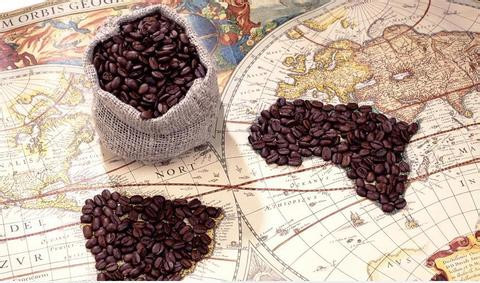Coffee "pedigree theory" coffee bean variety origin introduction
Coffee was born.
There are many legends about coffee, two of which are very popular, namely, the "shepherd's story" and the "Arab monk's legend."
The Shepherd's Story may also be called the Kaldi Legend. The story is set in the Ethiopian Plateau in the sixth century. According to legend, there was a shepherd named Kaldi in Ethiopia in the sixth century. One day, he found his sheep jumping there all of a sudden. He thought it was incredible. After careful observation, he realized that it was caused by the sheep eating a red fruit. So he plucked the fruit and gave it to the monks of the monastery, who felt refreshed after eating it. These fruits are now coffee beans.
The "legend of the Arab monk" may also be called the "legend of Shaq Omar." In 1258, Sheik Omar, a chieftain expelled from his people for crimes, wandered to Wasaba (in Arabia), far from his hometown of Mocha, and was so hungry and tired that he could no longer walk. As he sat on the root of the tree to rest, he noticed a bird flying up and perching on the branch, singing with a most pleasant voice he had never heard before. He looked carefully and saw that the bird had made this beautiful song after eating the fruit on the branch. So he picked all the fruits in that area and put them into a pot to boil them with water. Soon after, they began to emit a rich fragrance. After drinking them, he not only felt very good to drink, but also felt tired and refreshed. Therefore, he picked many of these magical fruits and brought them to boil soup for sick people to drink. Coffee was discovered, and Shelly Omar was exonerated for doing a lot of good.

Coffee's "pedigree"
As with red wine, coffee has a lot to do with where it comes from. The most famous coffee producing areas are as follows:
Brazil
The largest coffee producer. One of the most famous is Sandos coffee, it tastes mellow, neutral, can be boiled directly, or mixed with other types of coffee beans, is also a good choice. Other types of Brazilian coffee, such as Rio and Parana, can be produced in large quantities without much care, although they taste rough, but they are a good and inexpensive coffee.
Colombia
The second largest coffee producer after Brazil. More famous origin "Medellin","Manizares","Bogotá","Armenia", etc., the cultivated coffee beans are Arnika than species, taste quite rich, quality, price is also very stable, fried roasted coffee beans, more large and beautiful. From low to high quality products can be produced, some of which are rare in the world of good goods, taste mellow to love.
Mexico
Central America's leading coffee producer. The coffee here tastes comfortable and attractive, and the top Mexican coffees are Coatepec, Huatusco and Orizaba, among which Coatepec is considered one of the best coffees in the world.
Hawaii
In addition to sightseeing in Hawaii, don't forget that Hawaii also produces coffee beans---Kona. Sweet taste with pleasant wine acidity, very special. It is produced on Hawaii's southwest coast in Kon-a, Hawaii's most traditional and famous coffee.
Indonesia
Sumatra's high-grade mantelin, its unique aroma, slightly acidic taste, quality can be said to be the world's first. In addition, Arabica coffee produced in Java, bitter with sweet, sweet and sour aftertaste, long time does not disperse.
Costa Rica
Costa Rica's high latitudes produce coffee beans that are famous in the world for being rich, mild, but extremely acidic. The famous coffee is produced in the Central Plateau, where the soil consists of several layers of volcanic ash and dust.
Angola
The world's fourth largest coffee industry, but only produces a small amount of Arabica coffee, high quality is self-evident.
of Ethiopia
Home of arabic coffee. Growing at high latitudes requires a lot of manual care. Here is the famous Ethiopian mocha, which has a similar acidity to wine, aromatic and productive.
Jamaica
A national treasure of Jamaica, Blue Mountain Coffee is flawless in every way, just like wine. Grown at an altitude of more than 2000 meters, combined with the essence of baking technology developed, it is the best coffee.
Kenya
Kenya grows high-quality Arabica coffee beans, coffee beans almost absorb the essence of the whole coffee cherry, taste slightly sour, have a thick aroma, very popular with Europeans.
Yemen
Mocha coffee is familiar to everyone. Yemen's mocha coffee was once popular, blowing a mocha whirlwind around the world. Acid mellow, with a lubricating medium acid to strong acid, sweet character.
Peru
The up-and-coming Peruvian coffee is gradually opening its name to the world. More planted in high-altitude areas, planned planting makes the yield greatly improved, the taste is mellow, and the acidity is appropriate.
in Guatemala
Guatemala's central region is home to world-renowned coffee with excellent flavor. Coffee beans here with more than charcoal-burning flavor, cocoa incense, only slightly stronger acidity.
Important Notice :
前街咖啡 FrontStreet Coffee has moved to new addredd:
FrontStreet Coffee Address: 315,Donghua East Road,GuangZhou
Tel:020 38364473
- Prev

Coffee maker steam nozzle can clean jewelry
Another function of the coffee maker steam nozzle-cleaning jewelry. Dirt stubborn can first soak in hot water, extremely stubborn and complex structure such as to clean hollow spherical internal dirt, you can use a coffee maker to clean powder hot water soaked jewelry for 10 minutes, and then steam can easily spray off the dirt. I helped clean the bracelets, necklaces and rings of those foreign girls in the store.
- Next

Can you drink coffee like this? A different way of drinking coffee
Different coffee cultures, different ways of drinking coffee.
Related
- Beginners will see the "Coffee pull flower" guide!
- What is the difference between ice blog purified milk and ordinary milk coffee?
- Why is the Philippines the largest producer of crops in Liberia?
- For coffee extraction, should the fine powder be retained?
- How does extracted espresso fill pressed powder? How much strength does it take to press the powder?
- How to make jasmine cold extract coffee? Is the jasmine + latte good?
- Will this little toy really make the coffee taste better? How does Lily Drip affect coffee extraction?
- Will the action of slapping the filter cup also affect coffee extraction?
- What's the difference between powder-to-water ratio and powder-to-liquid ratio?
- What is the Ethiopian local species? What does it have to do with Heirloom native species?

